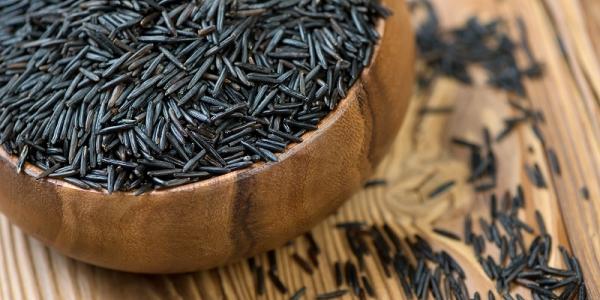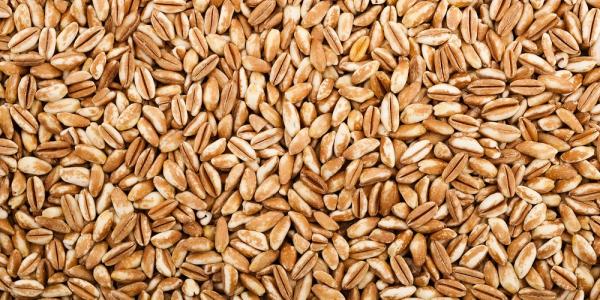Wild Rice Tomato Soup

Ingredients
- 1 T vegetable oil
- ½ c medium diced onion
- ½ c medium diced celery
- 4 c stemmed and rough cut kale
- 1½ T minced garlic
- 1 T tomato paste
- 2 quarts vegetable broth
- 2½ c canned diced tomatoes
- 1 bay leaf
- ½ t crushed red pepper
- 2 t dried oregano
- 1 c wild rice
- 2 t red wine vinegar
- 1 T chopped fresh rosemary
- 1 T chopped fresh thyme
- Salt and pepper to taste
Preparation
Heat oil in a soup pot over medium high heat; sauté onions, celery, and kale for 5-7 minutes.
Add garlic and tomato paste; sauté an additional 2 minutes stirring frequently.
Deglaze pot with vegetable broth, then add tomatoes, bay leaf, crushed red pepper, and dried oregano; stir well.
Add rice. Do not stir. Heat to a boil, reduce heat to simmer, and partially cover the pot with a lid. Simmer for about 60-70 minutes or until rice is tender
Remove from heat, stir in vinegar and fresh herbs, remove bay leaf, and adjust seasoning with salt and pepper as needed.
Learn More About wild rice
I lived for a stint in Minnesota where I was first introduced to wild rice. Maybe that’s why Minnesota and neighboring Wisconsin come to mind when I think of wild rice. So it was a surprise to me when I came across Barbara Barton’s new book, Manoomin: The Story of Wild Rice in Michigan. The waterways of our two peninsulas had extensive wild rice beds, some covering thousands of acres, hand-harvested for thousands of years.
The Anishinaabek (including Odawa, Ojibwe, and Potawatomi indigenous peoples) named it Manoomin meaning “the good berry.” Manoomin was a spiritual and cultural staple among the tribes of the Great Lakes Region. But as industry developed, the natural habitat for wild rice was altered or destroyed leaving only a few beds in Michigan. Restoration projects are underway to bring wild rice back to its former glory.
Manoomin continues to be a staple for some families. Outside of Indigenous communities, wild rice has grown in popularity in part because it is both an ancient whole grain and gluten free.
Actually, wild rice isn’t rice. And if you buy a packet in the supermarket, it isn’t truly wild. The seed of an annual aquatic grass, most wild rice on the market today is machine-harvested from cultivated paddies in Minnesota and California. Cultivated wild rice seeds are selected for characteristics that make the grains look uniform, and cook and taste consistent. Natural wild rice grains are darker, longer, and have more complex flavors than grains from cultivated strains. The most noticeable difference is cost. Still pricey as compared to other grains, cultivated wild rice is significantly less expensive than natural wild rice.
Dry wild rice will keep on the shelf for several years. Before cooking, rinse well, then simmer in water or broth in 1:4 ratio for 45 to 60 minutes to yield 4 cups cooked wild rice. Use it as you would any grain: soup, stuffing, salad, and pilaf. Pair it with nuts and dried fruit for a dish that’s over the top!
Peggy Crum, MA, RDFeatured Recipes

Rhubarb & Strawberry Crisp
Combine tart rhubarb with sweet strawberries, add a streusel topping, and bake until bubbly. Dessert doesn’t get easier—or more classic—than this. Serve warm with a scoop of vanilla ice cream. You’re sure to get rave reviews!

Farro Salad with Grilled Vegetables
Chewy farro grains are delicious in this autumn-y salad. Recipe yields enough for dinner for 2 to 4 with some left for a couple of lunches. To do this, make the base with dressing, farro, and grilled veggies. Add fresh veggies to the base as you go.

Pecan and Dark Chocolate Chip Cookies
Roasting amps up the flavor in everything including pecans. Chef Kurt's attention to detail takes a traditional chocolate chip cookie to another level of yum!

Onion Soup
Onions, the simplest of pantry staples, mingle with butter, broth, and herbs to become luxuriously smooth and delicious. Add "homemade" croutons and a blend of cheeses to make a complete and satisfying meal.





